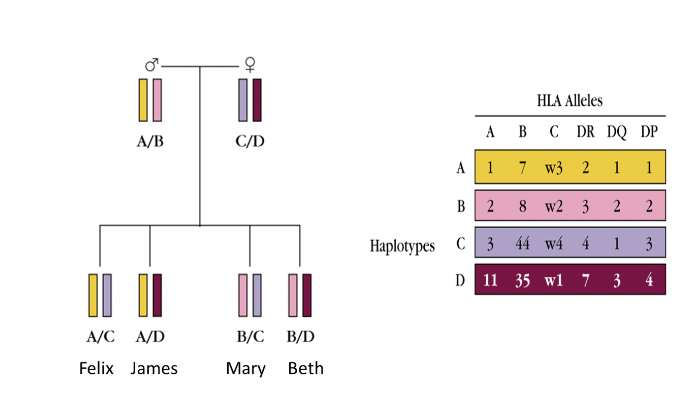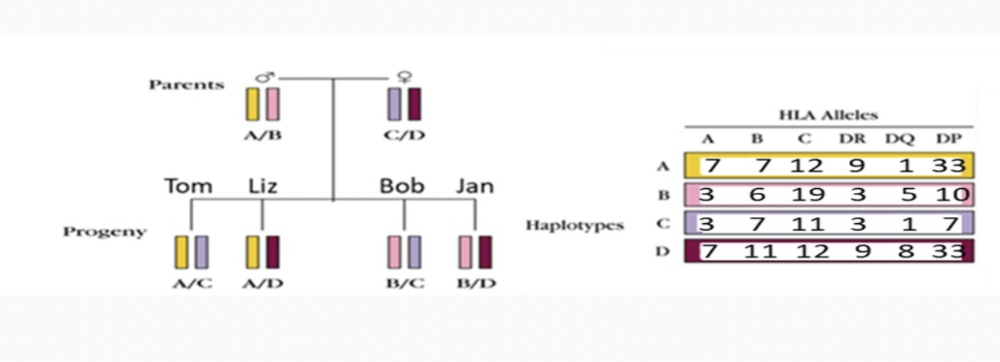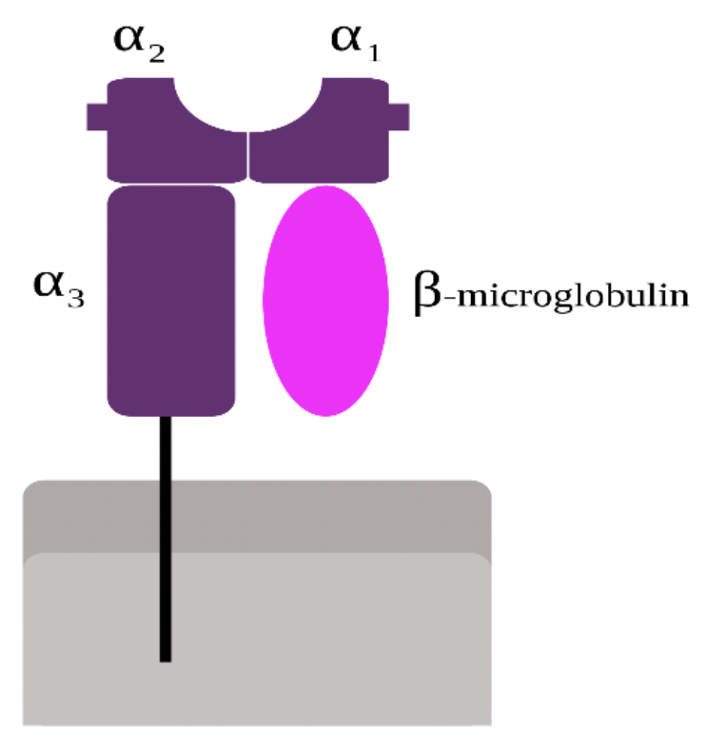Explain the role that MHC complexes play in presenting antigenic peptides to T cells
- MHC must be involved for a T-cell to bind to an antigen
- MHC "presents" the antigen to a T-cell
Explain the different ways in which antibodies and TCRs bind antigen.
*TCR= T cell recpetor
- For this class the antigen is always a protein (peptide)
- A T-cell does not interact with an intact protein
- the protein has to be broken down into peptide fragments, and a piece of it (the epitope) must bind to an MHC molecule, and THEN the t-cell can recognize the antigen
- Antigen peptides are non-covalently bonded to MHCs
What is MHC?
- MHC = major histocompatibility complex
- MHC is a protein complex expressed on the outside of almost every cell of our body
- It comes in two types: Class I and Class II
Describe the structure of the MHC-I and MHC-II complexes. What are they composed of? Where are they located? Identify MHC-I and MHC-II.
MHC-I:
- Structure: 3 domain protein
- Composition: alpha chain (⍺ chains 1, 2, and 3) and β-2 microglobulin protein
- Location: On the surface of nucleated cells
- The antigen peptide sits in the “peptide binding groove”
MHC-II:
- Structure: 4 domain protein
- Composition: ⍺ chain 1 and 2 and β chain 1 and 2
- Location: primarily located on the surface of antigen-presenting cells
MHC Class II presenting cells STILL present MHC Class I, too!
Correctly identify the type of T cell that expresses CD4 and the type of T cell that expresses CD8. Correctly describe the molecule that is bound by CD4 and by CD8.
Th= T helper cells
- express CD4 on the surface of the cell they are CD4+
- They are MHC Class II restricted they can only interact with a peptide that is presented from MHC class II.
- They are good at recognizing complex of bacterial peptide with MHC class II and Activates macrophage via cytokine release
Tc= T cytotoxic cells
- express CD8 on the surface of the cell they are CD8+
- They are MHC Class I restricted they can only interact with a peptide that is presented from MHC class I.
- They are good at recognizing a complex of viral peptide with MHC Class I and identifies and kills infected cells.
Correctly identify the cell types that express MHC-I and those that express MHC-II.
Class I
- The cells that have a nucleus
- examples: T & B cells, macrophages, dendritic cells, and neutrophils.
Class II
- very restrictive
- Bcells, a cell in the thymus, macrophages, and dendritic cells
Explain how the MHC gene locus got its name (major histocompatibility complex).
- HLA = Human Leukocyte Antigen. Effectively it’s just human MHC in general
- The MHC gene locus earned its name "major histocompatibility complex" because it was initially discovered through studies of tissue compatibility in transplantation, where certain proteins encoded by these genes were found to be crucial for determining whether tissues from one individual could be accepted by another.
- The term "major" reflects its significant role in immune recognition and compatibility.
Describe the general organization of the MHC gene locus. Which MHC genes encode which MHC proteins?
- MHC genes are clustered together on chromosome 6
- “Classic” MHC genes have red boxes around them on the slides
- A, B, and C for Class I
- DP, DQ, DR for Class II
- The A, B, and C, all encode the MHC class I protein. This means there are different versions of the same structure, with the same function. Different amino acid sequences.
- HLA E, F, and G are “non-classic”
- For MHC Class II, you need genes to encode the alpha and the beta to form the complex. Many people have several versions of Beta.
- DP, DQ, DR each encode alpha & beta. ABC each encode only the alpha chain. (Beta is encoded elsewhere).
Explain the meaning and biological relevance of allelic polymorphism with respect to the MHC genes.
- allelic polymorphism is many versions/forms of a gene
- In the human population (NOT in an individual), there are at least 1939 different versions of the HLA A gene
- DPB means DP beta chain / DPA means DP alpha chain
- the variations tend to be in the peptide binding groove
Explain why is it beneficial to express all of the MHC genes that we inherit.
- Expressing all of the MHC genes we inherit ensures a diverse array of cell surface proteins, enhancing the immune system's ability to recognize a wide range of pathogens.
- This diversity increases the likelihood of successfully presenting antigens to T cells and mounting effective immune responses against a variety of infectious agents.
Describe the meaning of a haplotype.
How many haplotypes does each individual have? (2)
- Haplotype: the linked set of MHC genes inherited on chromosome 6
- Each individual has two haplotypes. One from each parent
Explain how MHC genes are inherited (as a linked set of genes, haplotype).
- the linked set of genes inherited on chromosome 6 is a “haplotype”...we have 2 haplotypes; one from mom and one from dad
- *A is allele 1,7,w3,2, 1,1
- every cell in your body has these genes.
- possible to have crossing over in MHC region, but unlikely (because it is so small)
- R is showing a crossing over between C&D.
* Needs Clarification
Be able to predict if transplanted organs/tissues will be accepted or rejected based on the MHC haplotypes of transplant donor and recipient.
- There will be an attack on the tissue if the transplanted MHC is different.
- MHC is one of the biggest considerations when looking at organ transplantation. Likelihood of matching a sibling is 25%.
What do these mean?
H2
H2 b/b
HLA
H2- mouse MHC
b/b- is the haplotype
HLA- Human MHC
Tophat:
True/False: It is possible for a TH to present a MHC/peptide complex to a Tc.
True
Tophat:
Cell X expresses MHC-I on its surface but it does not express MHC-II on its surface. Which one of the following cells types is cell X most likely to be?
a.) Dendritic cell
b.) Naive B cell
c.) Hematopoietic stem cell
d.) Activated macrophage
e.) Memory B cell.
c.) Hematopoietic stem cell
Tophat:
True/False: There would be less MHC diversity in a mouse that was unable to express a functional form of the VDJ recombinase enzyme (RAG enzyme), than in a normal mouse that did express the VDJ recombinase enzyme.
False
How many (maximum number) unique forms (different allotypes)
of MHC-I can be expressed on the surface of a
single
nucleated cell?Select an answer and submit. For keyboard navigation,
use the up/down arrow keys to select an answer.
a.)1
b.)2
c.)4
d.)6
e.)Many hundreds or thousands
D.) 6

Which child in this family has the lowest level of MHC diversity?Select an answer and submit
a.) Felix
b.) James
c.) Mary
d.) Beth
A.) Felix

What is the % chance that a 5th child born into this family would have the exact same haplotypes as Bob?
aAlmost 0%
b100%
c25%
d50%
e75%
C.) 25%

Which one of the following statements about the MHC protein complex shown in the image is false?
a.)This type of MHC complex is present on the surface of T cells that express CD8 on their surface.
b.)This type of MHC complex is not present on the surface of B cells, dendritic cells, and macrophages.
c.)This type of MHC complex is bound by the T cell receptor present on T cells that express CD8 on their surface.
d.)The amino acids that establish non-covalent bonds with the peptide that is presented by this MHC complex, are located in the α1 and α2 domains.eThe complex might be HLA-A567.
b.)This type of MHC complex is not present on the surface of B cells, dendritic cells, and macrophages.
Analysis of a single cell reveals that the cell does express HLA-A, B, and C proteins but it does not express HLA-DP, DQ, or DR proteins on its surface. Based on this information alone, which one of the following statements about this cell is false?Select an answer and submit.
a.) This cell might be a TH cell.
b.)This cell cannot be a macrophage.
c.) This cell might be a dendritic cell.
d.) This cell does not express an immunoglobulin on its surface.
e.)This cell is not an erythrocyte (red blood cell).
c.) This cell might be a dendritic cell.
Which one of the following statements about MHC haplotypes is false?Select an answer and submit.
a.) An individual possesses two separate MHC haplotypes.
b.)Brother and sister twins might not share any haplotypes.
c.)Haplotype X and haplotype Y cannot share any similar MHC alleles.
d.)New haplotypes can be created by the process of homologous recombination (crossing over) during meiosis.
e.)Haplotypes contain MHC-I and MHC-II genes.
c.)Haplotype X and haplotype Y cannot share any similar MHC alleles.
Which one of the following statements about MHC-II is false?
a.) MHC-II is a two protein complex.
b.) MHC-II presents peptides to cells that have CD4 on their surface.
c.)MHC-II is present on B cells, macrophages, and dendritic cells.
d.) MHC-II binds to peptides using non-covalent bonds.
e.) MHC-II presents peptides to Tc cells but not to Th cells.
e.) MHC-II presents peptides to Tc cells but not to Th cells.
The MHC haplotypes of mouse #1 are represented as H2x/x . The MHC haplotypes of mouse #2 are represented as H2A/B. True/False: Mouse #1 and mouse #2 might be siblings from the same litter (the same parents).Select an answer and submit.
True